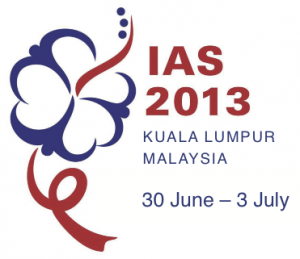ARVs and bone health: the role of NRTIs in second-line therapy
25 July 2013. Related: Conference reports, Side effects, IAS 7th Kuala Lumpur 2013.
 Simon Collins, HIV i-Base
Simon Collins, HIV i-Base
The final clinical late-breaker oral presentation at IAS 2013 reported significantly less reduction in bone mineral density (BMD) after a year on an NRTI-sparing combination in a randomised study compared to standard NRTI-containing treatment. [1]
Bone health is an unresolved complication of HIV and ART that bucks the trend for the generally beneficial impact of treatment to reduce both HIV-related and serious non-AIDS complications, mediated by reduced immune inflammation and activation. Although few individual drugs have been associated with greater reductions in BMD, ART itself, irrespective of the individual drugs has a negative impact on BMD compared to people not taking antiretrovirals. [2]
The current study, presented by Jennifer Hoy from Monash University, Melbourne was a substudy of a second-line therapy trial that randomised adults (>16 years-old) failing first-line NNRTI-based therapy to either NRTI-sparing combination of lopinavir/r plus raltegravir (n=108) or to the standard of care combination of lopinavir/r plus two NRTIs (n=102).
This was an international, 96-week, open label, non-inferiority trial, with an assumption that raltegravir would have less impact on BMD. The primary endpoint of the main study was viral suppression (<200 copies/mL) at week 48. The bone substudy was run at 8/37 sites with access to DEXA scans, in South Africa, India, Malaysia, Thailand and Argentina with a primary endpoint of changes in BDM between baseline and week 48 and additional bone-related secondary endpoints. BMD was measured at proximal femur and lumbar spine (L2-L4) measured by a standard protocol. Covariates in the multivariate analyses included: age, sex, ethnicity, BMI, smoking, blood pressure, HIV and ART markers (randomised treatment arm, CD4 counts, viral load, prior and on-study use of tenofovir and duration of use), body composition parameters (fat and lean mass) and other parameters influencing bone mass (e.g. hypogonadism, corticosteroids).
The two groups were well balanced for most demographics and baseline characteristics and included 50% women, but the NRTI-sparing arm had slightly fewer men (42% vs 54%) and fewer current smokers (13% vs 22%). Baseline CD4 count and viral load for the study population as a whole was 202 (IQR 104 – 307) cells/mm3 and 4.1 (IQR 3.5 – 4.7) log copies/mL respectively, indicating a wide range of clinical management: approximately 25% of patients were switching first-line treatment with either a CD4 count below 100 cells/mm3 or a viral load >50,000 copies/mL.
Approximately 51% were Asian, 43% African and 6% Caucasian. Also importantly, approximately 65% had BMI <20 and only 10% >30 kg/m2. Patients had been on treatment for a median of 3.4 years (IQR 2.0 – 6.0) and current NRTI-use included d4T (48%), AZT (34%) and tenofovir (17%). Approximately 45% of people used tenofovir in their second-line therapy.
Baseline rates of osteopenia and osteoporosis respectively were 20% and 1.5% in the proximal femur and 30% and 5% measured at the lumber spine.
At week 48, significant differences in mean (95%CI) BMD changes were reported for the NRTI-sparing vs control arms respectively: -2.9% vs -5.2% in the proximal femur [difference -2.4% (-3.5 to -1.2); p=0.0001] and -2.0% vs -4.2% in the lumber spine [difference -2.1% (-3.3 to-0.6); p=0.0006], adjusting for sex, BMI and smoking status. Similar and consistent differences were reported for changes in T-score and Z-score at each body site, although there were no significant differences in the odd ratio for the risk of developing new cases of osteopenia or osteoporosis.
In the multivariate analyses, lower nadir CD4 count (p=0.0173), tenofovir use (p=0.0001), BMI (p=0.0002) and vigorous exercise in the previous week (p=0.0157) were significantly associated with changes in BMD at both proximal femur and lumber spine. The exercise finding was unexpected and was not discussed further, though the explanation for this finding is unclear. Both prior (p=0.0303) and current (p=0.0002) use of tenofovir were significant.
comment
For adult care, if HIV was acquired after bone density had peaked, the impact of ART is more likely to be a longer-term concern, overlapping the complexities of reduced BMD and increased frailty with ageing, and several studies have already reported that HIV is associated with an increased risk of fractures. [4]
For children, adolescents and young adults, when HIV and treatment may have reduced natural bone development before peaking by age 30 years, this may become a caution from the use of earlier ART. Further research may support interventions to manage bone health that maximises the period of bone growth in order to prepare for reduction that will occur much later in life.
The BMD substudy of the START trial will provide a valuable longitudinal dataset to look at the impact of HIV, treatment and age. [3]
References:
Unless stated otherwise, references are to the Programme and Abstracts for the 7th IAS Conference on HIV Pathogenesis, Treatment and Prevention 30 June – 3 July 2013, Kuala Lumpur.
- Hoy J et al. Changes in bone mineral density over 48 weeks among participants randomised to either lopinavir/ritonavir (LPV/r) + 2-3N(t)RTI or LPV/r + raltegravir as second-line therapy: a sub-study of the SECONDLINE trial. 7th IAS Conference, Kuala Lumpar, 2013, Late breaker oral abstract WELBB05.
http://pag.ias2013.org/Abstracts.aspx?SID=74&AID=2962 - Grund B et al. Continuous antiretroviral therapy decreases bone mineral density. AIDS. 2009 Jul 31;23(12):1519-29. doi: 10.1097/QAD.0b013e32832c1792.
http://journals.lww.com/aidsonline/toc/2009/07310
http://journals.lww.com/aidsonline/Fulltext/2009/07310/Continuous_antiretroviral_therapy_decreases_bone.10.aspx - Strategic Timing of AntiRetroviral Treatment (START) study: bone mineral density substudy (001F).
http://insight.ccbr.umn.edu/start/ - Dao C et al. Higher and increasing rates of fracture among HIV-infected persons in the HIV Outpatient Study compared to the general US population, 1994 to 2008. 17th CROI 2010. Oral abstract 128. http://www.retroconference.org/2010/Abstracts/37582.htm

